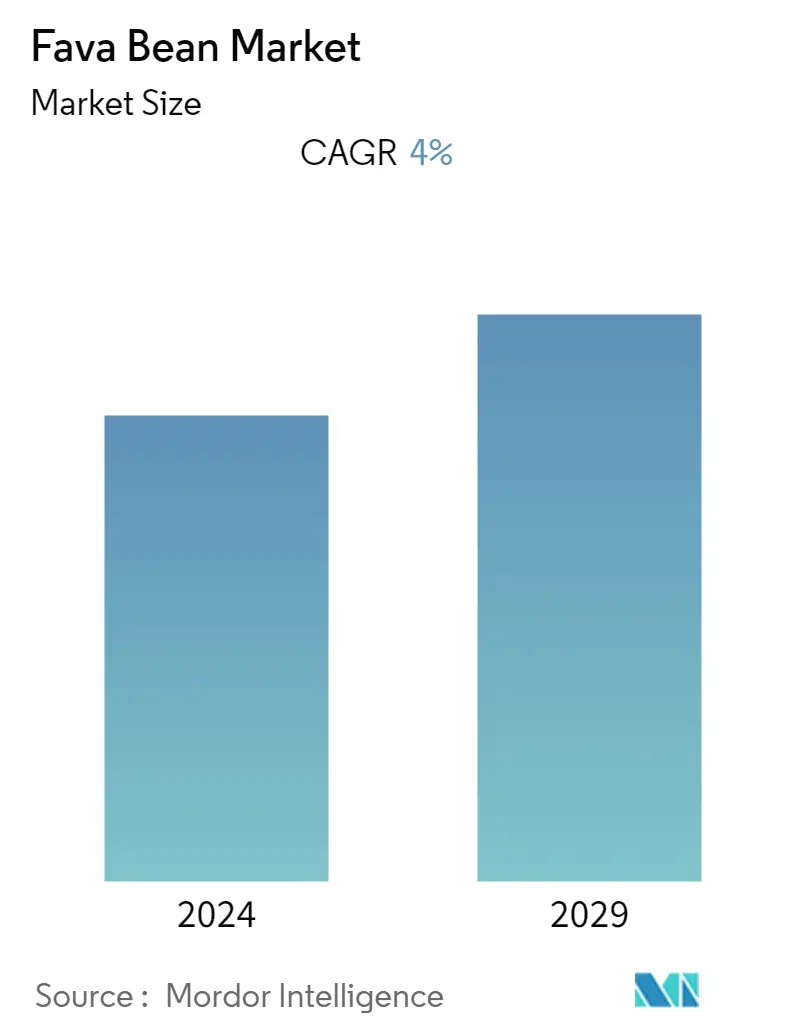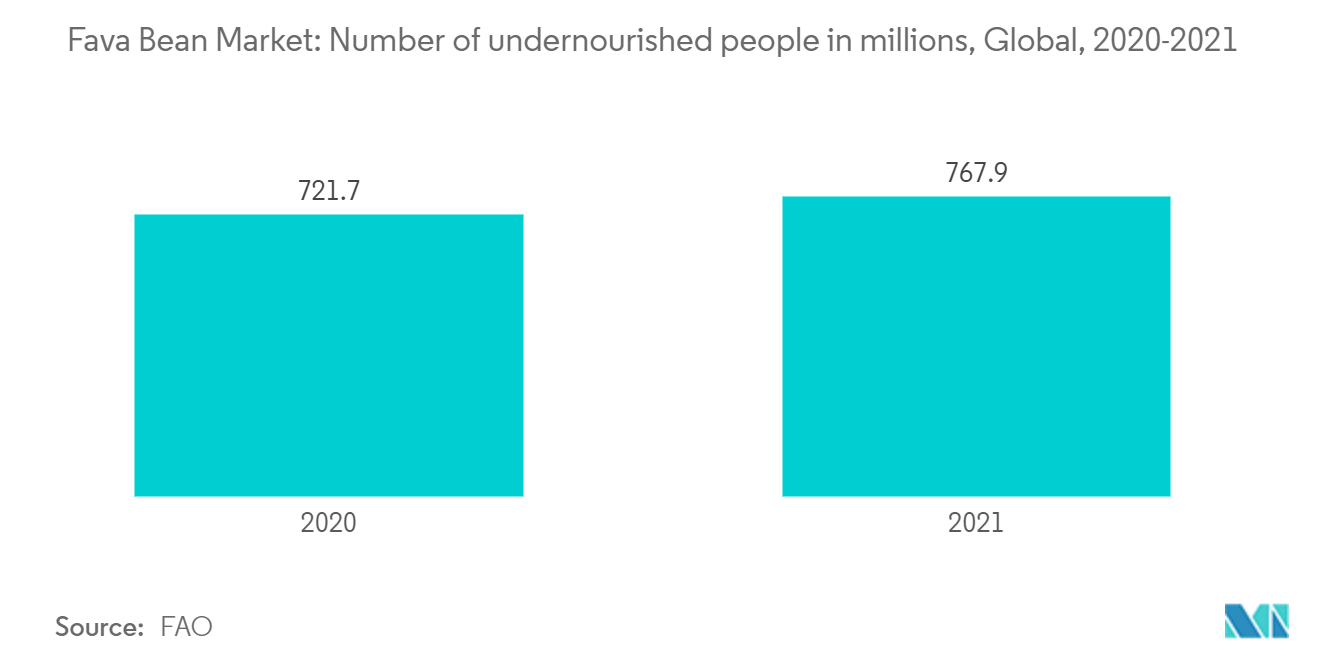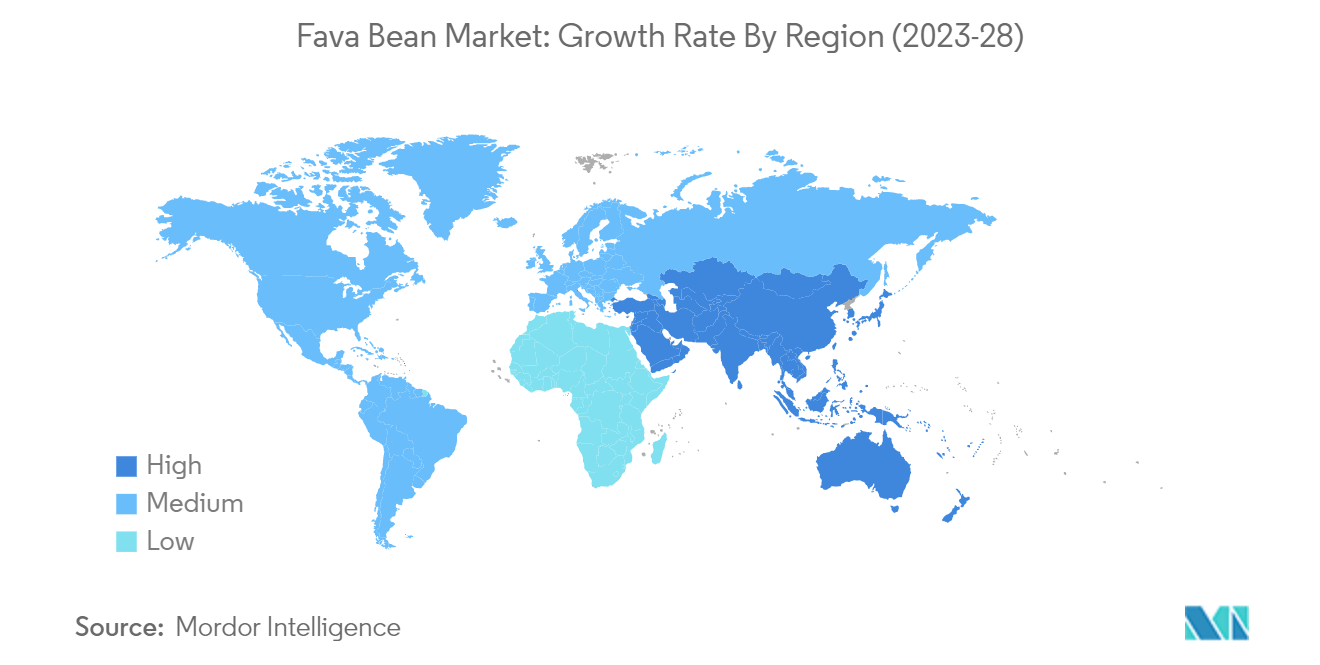Fava Beans Market Size

| Study Period | 2019 - 2029 |
| Base Year For Estimation | 2023 |
| Forecast Data Period | 2024 - 2029 |
| CAGR | 4.00 % |
| Fastest Growing Market | North America |
| Largest Market | Asia-Pacific |
Major Players*Disclaimer: Major Players sorted in no particular order |
Fava Beans Market Analysis
The global fava bean market is projected to register a CAGR of 4.0% during the forecast period.
- The market is being driven by the increasing consumption of fava beans owing to the rising interest in adopting a healthy lifestyle and nutritious diet. Fava beans are a good source of protein, fiber, and carbohydrates. In terms of mineral content, fava beans are rich in calcium, iron, and magnesium, among others. The drive towards maintaining a healthy lifestyle through healthy eating trends and increasing awareness about the benefits associated with fava beans has spurred market growth.
- Fava beans are increasingly used in various recipes across Middle Eastern and Asian cuisines as they are an excellent and versatile addition to a healthy, balanced diet. In addition, the rising trend of vegetarianism is also anticipated to bolster the consumption of fava beans in the coming years. Fava beans are considered effective in maintaining blood pressure, boosting the immune system, and improving bone health in the human body. Fava bean flour is also used in the production of bread and pasta, which drives the global fava bean market. Continuous volatility in fava beans prices hinders the growth of the global fava beans market.
- For the past few years, there has been an increasing trend of veganism in Europe and the United States, spreading worldwide. Moreover, people are focused on plant-based diets, which has been the reason for the higher consumption of fava beans. The intake of animal protein, which is associated with high cholesterol levels, fat, and calories, increases the risk of cardiac diseases, high blood sugar levels, and obesity. Hence, people are showing an inclination toward vegan sources of protein.
Fava Beans Market Trends
This section covers the major market trends shaping the Fava Bean Market according to our research experts:
Growing Demand for Nutritional Food
- The high nutritional benefits and increased availability of fava beans through organized retailing have been one of the primary drivers of the global fava bean market. Healthy eating trends around the world are promoting the consumption of foods that are rich in nutrients. Thus, the demand for fava beans is increasing among health-conscious consumers, thereby promoting the growth of the global fava beans market.
- The rapidly growing vegan population on a global level due to increasing concerns regarding cardiovascular disorders associated with red meat is expected to remain a favorable factor for the market. These beans are considered a rich protein source, resulting in increased demand from fitness-conscious consumers.
- In addition to the decline in meat consumption, people are becoming health-conscious and switching their protein sources from animal-based to plant-based, as there are increasing concerns about organic food worldwide. Owing to this, the European Union developed a long-term strategy to reduce greenhouse gas emissions. The European Vegetarian Union (EVU) encourages the EU commission to limit the production of animal products within its climate policy. The European Union also encourages decision-makers to implement strategies to support the societal dietary transition.

Asia-Pacific Dominates the Market
- Globally, Asia-Pacific is the primary producer of fava beans. In Asia-Pacific, dry and green fava beans accounted for 2.7 million metric tons in 2021, which occupied 35.3% of the global fava bean production. The total fava bean production in Asia-Pacific was 2.5 million metric tons in 2019 which increased to 2.7 million metric tons in 2021. The increase in production is associated with increasing consumer demand and high export potential due to its nutritional value.
- China is the major producing country in the region. The fava bean production in China was 1.9 million metric tons in 2021. China accounted for 69.1% of the region's fava bean production in 2021. Fava bean is widely used in Sichuan cuisine and is called Sichuan beans in Chinese. It is used as a vegetable and also as a seasoning. Growing consumption of roasted seeds as a low-fat snack in India and neighboring countries is among the factors driving demand in the region.
- With reduced profits for food legume crops, their area and production have decreased within China. At the same time, the rising consumer demand for vegetable food legumes as a healthy food has led to attractive market prices and sharp increases in production within the country. With the advantages of short growing periods and biological nitrogen fixation (BNF), legumes are playing an important role in the cropping systems in the region. As ideal intercrops, it can increase crop yields and the economic benefits of the intercropping systems to meet the increasing demand for food.

Fava Beans Market News
- January 2023: Tesco PLC, a British multinational grocery, partnered with the fava bean processor AB Mauri and its own-brand suppliers, including ready meal producer Samworth Brothers, to trial the fava bean across various product ranges and ingredients. This will cause an increase in demand in the United Kingdom.
- September 2021: The University of Sydney released a new fava bean variety called FBA Ayla, which provides an improved fava bean for growers in Australia's northern New South Wales and southern Queensland region.
- January 2021: Chongqing Academy of Agricultural Sciences, Qinghai University, and Chongqing Agricultural Technology Extension Station developed Doumei 1 fava bean variety with both horticultural and food functions.
Fava Beans Market Report - Table of Contents
1. INTRODUCTION
- 1.1 Study Assumptions and Market Definition
- 1.2 Scope of the Study
2. RESEARCH METHODOLOGY
3. EXECUTIVE SUMMARY
4. MARKET DYNAMICS
- 4.1 Market Overview
- 4.2 Market Drivers
- 4.3 Market Restraints
- 4.4 Value Chain Analysis
5. MARKET SEGMENTATION
-
5.1 Geography (Production Analysis, Consumption Analysis by Value & Volume, Import Analysis by Value & Volume, Export Analysis by Value & Volume and Price Trend Analysis)
- 5.1.1 North America
- 5.1.1.1 United States
- 5.1.1.2 Canada
- 5.1.1.3 Mexico
- 5.1.2 Europe
- 5.1.2.1 Germany
- 5.1.2.2 United Kingdom
- 5.1.2.3 France
- 5.1.2.4 Russia
- 5.1.2.5 Spain
- 5.1.2.6 Sweden
- 5.1.2.7 Italy
- 5.1.3 Asia-Pacific
- 5.1.3.1 China
- 5.1.3.2 Japan
- 5.1.3.3 Australia
- 5.1.3.4 Iran
- 5.1.4 South America
- 5.1.4.1 Argentina
- 5.1.4.2 Peru
- 5.1.4.3 Brazil
- 5.1.5 Africa
- 5.1.5.1 Ethiopia
- 5.1.5.2 Egypt
- 5.1.5.3 Sudan
- 5.1.5.4 Morocco
6. MARKET OPPORTUNITIES AND FUTURE TRENDS
** Subject To AvailablityFava Beans Industry Segmentation
Fava beans are the edible seeds of the legume crop Vicia faba, otherwise known as faba beans, horse beans, or broad beans. The seeds are around 2 to 3 cm long and occur in various colors, including yellow, green, brown, black, and even violet. It is widely cultivated as a crop for human consumption and as a cover crop.
The fava bean market includes production analysis (volume), consumption analysis (value and volume), export analysis (value and volume), import analysis (value and volume), and price trend analysis across the globe. The market is segmented by geography into North America, Europe, Asia-Pacific, South America, and Africa.
The report offers the market size and forecasts in terms of volume in metric ton and value in USD thousand for all the above segments.
| Geography (Production Analysis, Consumption Analysis by Value & Volume, Import Analysis by Value & Volume, Export Analysis by Value & Volume and Price Trend Analysis) | North America | United States |
| Canada | ||
| Mexico | ||
| Geography (Production Analysis, Consumption Analysis by Value & Volume, Import Analysis by Value & Volume, Export Analysis by Value & Volume and Price Trend Analysis) | Europe | Germany |
| United Kingdom | ||
| France | ||
| Russia | ||
| Spain | ||
| Sweden | ||
| Italy | ||
| Geography (Production Analysis, Consumption Analysis by Value & Volume, Import Analysis by Value & Volume, Export Analysis by Value & Volume and Price Trend Analysis) | Asia-Pacific | China |
| Japan | ||
| Australia | ||
| Iran | ||
| Geography (Production Analysis, Consumption Analysis by Value & Volume, Import Analysis by Value & Volume, Export Analysis by Value & Volume and Price Trend Analysis) | South America | Argentina |
| Peru | ||
| Brazil | ||
| Geography (Production Analysis, Consumption Analysis by Value & Volume, Import Analysis by Value & Volume, Export Analysis by Value & Volume and Price Trend Analysis) | Africa | Ethiopia |
| Egypt | ||
| Sudan | ||
| Morocco |
Fava Beans Market Research FAQs
What is the current Fava Bean Market size?
The Fava Bean Market is projected to register a CAGR of 4% during the forecast period (2024-2029)
Which is the fastest growing region in Fava Bean Market?
North America is estimated to grow at the highest CAGR over the forecast period (2024-2029).
Which region has the biggest share in Fava Bean Market?
In 2024, the Asia-Pacific accounts for the largest market share in Fava Bean Market.
What years does this Fava Bean Market cover?
The report covers the Fava Bean Market historical market size for years: 2019, 2020, 2021, 2022 and 2023. The report also forecasts the Fava Bean Market size for years: 2024, 2025, 2026, 2027, 2028 and 2029.
Fava Bean Industry Report
The Global Fava Beans Market report provides a comprehensive industry analysis, covering various aspects such as market size, market share, and market trends. The report offers an in-depth industry overview, highlighting the market growth and market forecast for the coming years. It includes detailed industry reports and market research, providing valuable insights into market segmentation and market value.
The report also presents a thorough market analysis, including production analysis, consumption analysis, export analysis, and import analysis. The industry information is segmented by geography, covering North America, Europe, Asia-Pacific, South America, and Africa. This segmentation helps in understanding the market dynamics and market outlook in different regions.
The market report includes a historical overview and a market forecast outlook, offering a clear picture of the market trends and market predictions. The industry research also covers price trend analysis, providing insights into the market data and market review. The report highlights the market leaders and industry sales, giving an overview of the competitive landscape.
The report example provided in the form of a report PDF download offers a sample of the industry analysis, showcasing the market statistics and industry size. The market leaders' strategies and market segmentation are also discussed, providing a complete market overview. The industry outlook is positive, with a focus on market growth and market value.
Overall, the Global Fava Beans Market report is a valuable resource for research companies and stakeholders, offering detailed industry trends and market data. The report's comprehensive coverage and industry statistics make it an essential tool for understanding the market dynamics and making informed business decisions.



